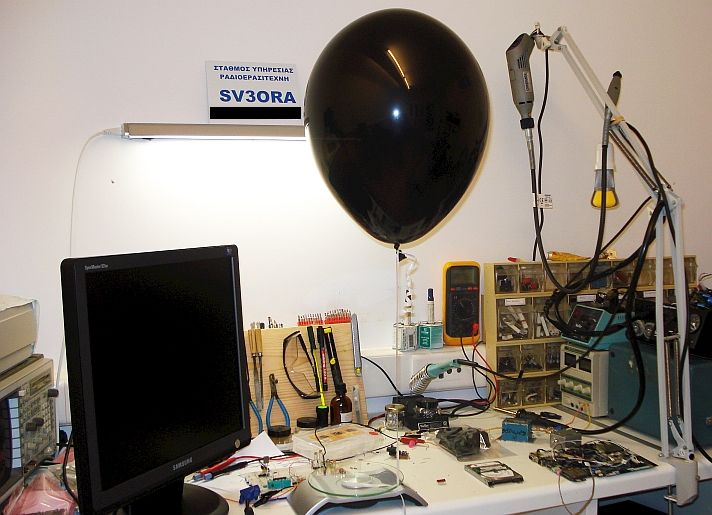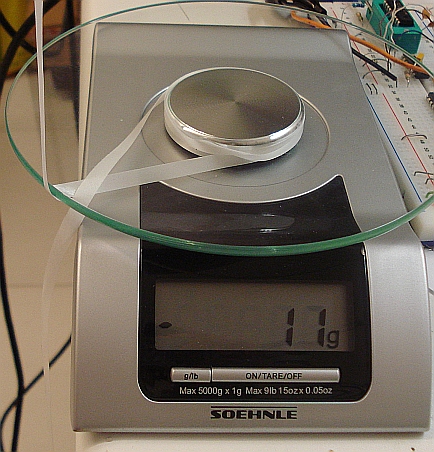
Personal ballooning
A pioneer concept
approach
by SV3ORA
Updated 11-11-2014
First historical
flight:
September the 3rd, 2014
Introduction
Personal ballooning is a term I have thought of, to describe a new exciting hobby. It is all about launching small-sized, gas-filled balloons, with an appropriate payload, to high altitudes.
The concept was inspired from the advancements in satellite technology. To lower down cost, manufacturers and enthusiasts all over the world, working towards miniaturizing these machines from full-scale satellites to satellites the size of the thumb.

Satellites miniaturization
My idea was to apply the same concept to the ballooning technology. Like mini satellites, personal balloons have limited capabilities compared to their larger counterparts, but they oppose significant advantages in specific applications.

Balloons miniaturization
Key issues
The main issues
considered for personal ballooning, is cost, availability, altitude and weight.
Per-flight cost can be extremely low compared to weather balloons and this can
be considered as a major advantage. The low cost
has to do not only with the balloon itself, but also to the amount of lifting
gas required per-flight. Balloons are also widely available in different sizes
and lifting gasses like Helium and home-produced hydrogen, are common for
inflating them. However, the most limiting factor and the greatest challenge in
personal ballooning, is the weight of the payload, which must be kept ultra
lightweight for a successful flight. Maximum altitude could be also an issue
(and this relates to the weight of the payload and the amount of lifting gas
required), but this must be experimentally determined.
Helium or Hydrogen?
Both Helium and Hydrogen gasses (and some others) can be used for personal ballooning. However, one has to carefully consider the advantages and disadvantages of each gas, as well as their cost and availability.
Hydrogen, being the lightest existing gas (14 times less dense than air), seems to be the most appropriate gas for lifting. Moreover, it is very cheap and easy to produce even at home, e.g., by electrolysis of dilute solution of saltwater or by displacement from an acid or water, by a reactive metal, such as magnesium or aluminium. However, hydrogen has several disadvantages:
Hydrogen is extremely flammable. Some countries have banned the use of hydrogen as a lift gas for commercial vehicles but it is allowed for recreational free ballooning. The high cost of helium (compared to hydrogen) has led researchers to re-investigate the safety issues of using hydrogen as a lift gas. With good engineering and good handling practices, the risks can be significantly reduced.
Because the hydrogen molecule is very small, it can easily diffuse through many materials, so that the balloon will deflate quickly. (That's the reason why some hydrogen or helium-filled balloons are coated by a thin layer of aluminium.)
Helium is the second lightest gas. For that reason, it is an attractive gas for lifting as well. A major advantage is that this gas is noncombustible. However, the use of helium has some disadvantages, too:
The same diffusion problem as above described with hydrogen.
Helium is expensive, although in these small quantities required for personal ballooning, cost is not a big issue.
Although abundant in the universe, helium is very scarce on earth. The only commercially viable reserves are a few natural gas wells, mostly in the US, that trapped it from the slow alpha decay of radioactive materials within the earth. By human standards helium is a non-renewable resource that cannot be practically manufactured from other materials. When released into the atmosphere, e.g., when a helium-filled balloon leaks or bursts, it eventually escapes into space and is permanently lost. However, helium is the gas of choice for inflating the flying party balloons, so it may be easy to find it locally in small quantities, from related shops.
Practically, for such small quantities required for the lifting gas used in personal ballooning, the choice of whether to use hydrogen or helium, is mainly up to the availability of helium in your area. Hydrogen may be relatively easy to produce at home, but the total cost (and the hazards) associated with the inflation of a hydrogen balloon, may be much higher than buying an already helium-filled balloon. In the case of electrolysis for hydrogen production, the total cost is related to the electrical power required and the solution elements of the electrolysis. When reactive metals are used for hydrogen production, the cost and availability of the metal is of concern, instead of the electrical power.
Practical experiments
To evaluate the
issues related to personal ballooning and their practicality, I run a series of
experiments using helium-filled balloons. These experiments and the concluded
results/observations, are presented below.
September the
3rd, 2014
Evaluation of the maximum payload and the total cost of a standard-sized
helium-filled balloon
A balloon was filled with helium gas, on a local flying-party-balloon shop. The inflated balloon had a 90cm horizontal perimeter and a 100cm vertical perimeter.

Helium-filled balloon schematic

Helium-filled balloon hanging above my lab bench. For size comparison, there is a 19 inch computer monitor on the left.
To evaluate the maximum payload, a digital scale was used and the balloon was tied to it. I had to admit, the results were better than I was expecting. I expected a payload of about 4-5 grams, but it was double that.

Non-inflated
balloon weight: ?
Non-inflated balloon cost: 0.2 Euros
Single helium-filled balloon maximum payload: 11 grams
Total single helium-filled balloon cost (filled in balloon-shop): 1 Euro
Total single helium-filled balloon cost (filled at home, using the smallest disposable
helium tank that fills 10 balloons): 3 Euros
Note that the maximum payload of 11 grams should never be exceeded, for successful balloon lifting. Practically, the payload must be quite lighter than 11 grams, if the balloon is needed to reach maximum height in reasonable time.

If you need to be ever-ready (for example when the balloon-shop is closed), a disposable helium tank can be purchased, to fill your own helium balloons at home, whenever needed. The smallest disposable helium tank available locally, can fill up to ten balloons of this size and cost 35 Euros. This means that the cost-per-flight seems to be more than 3 times higher initially. However, the actual total cost-per-flight of a helium-filled balloon that is filled in balloon-shop, is not really 1 Euro. The gasoline that you will burn to reach the balloon shop, your effort and your time have to be considered.
This experiment shows that a single helium-filled balloon flight, can cost between 1-3 Euros and can lift about 10 grams of payload. To put it differently, every 10 grams of payload you need to fly, 1-3 Euros are required.

After successfully accomplished the goal of the experiment, I could not resist the chance to fly the balloon, even without a payload, just to get a first visual indication of how high it can go. That set the first historical flight (well, short of...) to be September the 3rd, 2014.

Here is a picture of the flying balloon in comparison to the houses nearby. The balloon is that little black dot, at the middle of the picture. The colour of the balloon, was purposively chosen to be black, so that it can be easily seen in the light-blue sky. After 2-3 minutes, I could not see the balloon in naked eye and I used a small telescope, to locate it.
September the
11th, 2014
Evaluation of the 1+3/4 balloon concept
Any typical balloon flight will eventually reach at it's maximum altitude. As the balloon lifts up to reach at it's maximum altitude, it expands. This expansion happens because the surrounding atmosphere pressure at higher altitudes is lower than the pressure of the lifting gas inside the balloon. As the balloon expands more and more, it reaches a point where the balloon material cannot withstand any more the high tension caused by the expansion and it explodes. At this point, the balloon has reached it's maximum altitude and when the explosion happens, the payload falls rapidly and violently towards the ground.
The above, happens in any gas-filled balloon personal or meteorological, if no means of controlling it's altitude is present. To overcome the problem of the violent falling of the payload to the ground, meteorological balloons may employ the use of parachutes or other mechanisms to increase the payload strength to vibrations. In personal ballooning, the use of parachutes is not suitable, due to the limited maximum payload weight. However, even without a parachute, vibrations are less likely to affect the payload, because of it's very light weight. The falling back to earth, is not so intense as in heavier meteorological balloon payloads.
However, a simple means of controlling the flight, although not mandatory, is beneficial. Although, in the case of meteorological ballooning this is difficult to happen, in the case of personal ballooning, a simple mechanism could be used as a means of controlling the flight and extend it's duration even more. Even though more lifting gas is required, I believe it is worth the effort, as it should greatly expand the duration of the time. I called it, the 1+3/4 balloon.

The 1+3/4 balloon, is a composite self driven balloon "engine", composed of two balloons. One of these balloons is filled with lifting gas at 100%, whereas the other is filled at about 75% or so. It is important that the total weight of the payload is adjusted, so that when the smaller balloon alone is attached to it, the payload floats to the air, without getting lifted or lowered. A reasonable practical approach would be to add small weights to the payload until it floats to the air, when attached to the smaller balloon alone. When this critical weight adjustment is completed, the bigger balloon is also attached to the payload.
During flight, the 1+3/4 balloon, will lift the payload up to a maximum altitude. The payload will reach this maximum altitude at a shorter time, because of the larger amount of lifting gas in contrast to the single balloon. When maximum altitude is reached, the high internal pressure will cause the larger balloon to explode first (assuming the two balloons are of the same type, having roughly equal strengths). At the same time, the smaller balloon has expanded but it is not exploded, because it's maximum strength point has not been reached. Because the payload weight has been adjusted so that the smaller (now expanded) balloon cannot lift the payload any more, the payload will remain floating in the air at this maximum altitude, until the lifting gas molecules gradually diffuse through the balloon material.
Assuming that the balloon is helium filled, the total cost of this composite balloon will be 2-6 Euros, depended on the filling option you choose. It is about twice the cost for a single balloon, but the idea that the payload could stay at maximum altitude for hours or maybe days, is very intriguing and may well worth the extra cost.
To be continued...